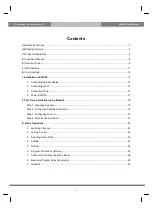
27
English
DESCRIPTIONS OF THE FUNCTIONS
1. CENTER DELAY (Adjusting the delay
of center sounds (dialog etc.))
Control range: 0 ms to 5 ms (in 1 ms step)
Preset value: 0 ms
*
This adjustment is effective only when the Dolby Digital
(AC-3) is decoded and the signals of selected source
encoded with the Dolby Digital (AC-3) contain center-
channel signals.
Adjusts the delay between the main sounds (at the main
channels) and dialog etc. (at the center channel).
The larger the value, the later the dialog etc. is generated.
This is for making sounds from the left main, center and right
main speakers reach your listening position at the same time
by delaying the sound from the center speaker if the distance
from the center speaker to your listening position is shorter
than the distance from the left or right main speaker to your
listening position.
2. DYNAMIC RANGE (Adjusting dynamic
range)
Choices: MAX/STD/MIN
Preset position: MAX
*
This adjustment is effective only when the Dolby Digital
(AC-3) is decoded.
MAX:
“Dynamic range” is the difference between the
maximum level and the minimum level of sounds.
Sounds on a movie originally designed for movie
theaters feature very wide dynamic range.
Dolby Digital (AC-3) technology can bring the original
sound track into a home audio format with this wide
dynamic range unchanged.
In this position, a source encoded with the Dolby
Digital (AC-3) is reproduced in the original sound
track’s wide dynamic range providing you with
powerful sounds like a movie theater.
Selecting this position will be more ideal if you can
listen to a source in a high output level in a room
specially soundproofed for audio/video enjoyment.
STD (Standard):
Powerful sounds of extremely wide dynamic range
are not always suitable for home use. Depending
upon the condition of your listening environment, it
may not be possible to increase the sound output
level as high as a movie theater. However, in a level
suitable for listening to in your room, the low level
parts of source sound cannot be heard well because
they will be lost among noises in your environment.
Dolby Digital (AC-3) technology also made it
possible to reduce an original sound track’s dynamic
range for a home audio format by “compressing” the
data of sound.
In this position, a source encoded with the Dolby
Digital (AC-3) is reproduced in the “compressed”
dynamic range of the source suitable for low level
listening.
MIN:
In this position, dynamic range is more reduced than
in the STD position. Selecting this position will be
effective when you must listen to a source in
extremely low level.
3. LFE LEVEL (Adjusting the output
level at the LFE (low frequency effect)
channel)
Control range: –14 dB to 0 dB (in 2 dB step)
Preset value: 0 dB
*
This adjustment is effective only when the Dolby Digital (AC-
3) is decoded and the signals of selected source encoded
with the Dolby Digital (AC-3) contain LFE signals.
Adjusts the output level at the LFE (low frequency effect)
channel. If the LFE signals are mixed with signals at other
channels to output them from the same speakers, the ratio of
LFE signal level to the level of other signals are adjusted. (See
page 6 for details about the LFE channel.)
4. CENTER SPEAKER
5. REAR SPEAKER
6. MAIN SPEAKER
7. LFE/BASS OUT
See pages 22 to 23 for details. (Once you have selected
proper modes, you do not have to make a setting change until
any alteration is made in your speaker system.)
8. TV/DBS INPUT (Selecting the initial
input mode of the sources connected
to the TV/DBS input terminals)
For the sources connected to the TV/DBS input terminals of
this unit only, you can designate the input mode that is
automatically selected when the power of this unit is switched
on.
AUTO:
In this position, the AUTO input mode is always
selected when the power of this unit is switched on.
LAST:
In this position, the input mode you have selected
last time is memorized and will not be changed even
if the power of this unit is switched on.
*
See page 29 for details about switching the input mode.
















































